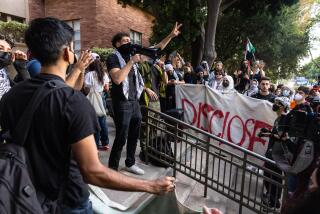Palestinian Police Curb Protests Against Israelis
NABLUS, West Bank â Palestinian demonstrators clashed with Israeli forces throughout the West Bank on Sunday, but Palestinian police intervened to contain the violence.
In most of the West Bank cities, Palestinian youths burned tires and threw stones at Israeli troops guarding Jewish shrines and border checkpoints.
Scores of the protesters were treated for rubber-bullet wounds and tear-gas inhalation, but there were none of the feared fatalities.
With Israeli tanks positioned on the edge of town, Arab police in the Palestinian-ruled city of Nablus fired into the air and formed a human chain to keep about 5,000 demonstrators away from Israeli soldiers at Josephâs Tomb, a Jewish shrine. Israeli army chiefs had warned that they would intervene if the Palestinians failed to keep control at the site--as happened in September, when six soldiers were killed during riots there.
Fatah, the political organization of Palestinian Authority President Yasser Arafat, had called for the mass demonstrations to protest Israeli Prime Minister Benjamin Netanyahuâs decision to build a Jewish neighborhood on a hill in southeastern Jerusalem that Israelis call Har Homa and Palestinians call Jabal Abu Ghneim.
It was the Palestiniansâ 11th consecutive day of street skirmishes over the new settlement, but Sundayâs protests were arranged to coincide with demonstrations in Israel by Israeli Arabs marking Land Day. The day commemorates a 1976 protest over the expropriation of Arab-owned land in northern Israel in which troops killed six Israeli Arabs.
Sundayâs protests began in the village of Beit Sahur, near Bethlehem, when thousands of mourners marched behind the Palestinian-flag-draped body of a 20-year-old university student shot dead in clashes with Israeli troops the night before.
Family members wailed with grief over the slain man as fellow students shouted that Abdullah Khalil Abdullah Salahâs death would not be in vain. Fatah distributed color photographs of the engineering student to honor âthe martyr, the hero, Abdullah Salah.â
It had been feared that the shooting would ignite widespread violence Sunday. Palestinian police and hospital officials assert that Abdullah Salah was killed by an Israeli soldierâs live fire. The Israeli army denies it.
Soon after the funeral ended, young men with slingshots and masks set up street barricades in Beit Sahur and Bethlehem and began hurling rocks at Israeli soldiers, who fired back with tear gas and rubber bullets.
âThis is not about confronting the Israeli army. It is about defending our rights,â said Mufid abu Saadeh, 32, who like most of the men on his street spent time in Israeli jails during the six-year uprising against Israeli rule known as the intifada.
Not all the neighbors, however, joined in the melee. A 30-year-old woodcarver who gave his name only as Awni said he felt too âapatheticâ to throw stones. âI feel there is no reason. Jabal Abu Ghneim is gone. Everything is gone,â he said as a cloud of tear gas wafted by.
âDuring the intifada we fought for something we believed in. Today there is nothing to fight for. . . . The [ruling Palestinian] Authority is not doing anything.â
The 3 1/2-year peace process has come to a halt in the last two weeks with Israelâs ground breaking on the housing project and a subsequent suicide bombing at a Tel Aviv cafe March 21 that left three Israelis dead and nearly 50 wounded.
Israel froze political negotiations after the bombing by a member of the militant Islamic group Hamas, and the Palestinians have suspended intelligence cooperation. U.S. peace envoy Dennis B. Ross warned at the end of a two-day trip here last week that calm must be restored if the peace process is to resume.
After a meeting of Arafatâs Cabinet and the Palestine Liberation Organizationâs Executive Committee in Gaza City on Saturday night, Information Minister Yasser Abed-Rabbo responded: âAny initiative, including the American one, will not succeed unless it deals with the reasons for the eruption of violence--mainly the policy of confiscation of Palestinian land and the expansion of Jewish settlements in Jerusalem and the West Bank.â
The Palestinians apparently heeded Rossâ warning nonetheless. Their police forces worked hard to rein in the street fighting in Gaza, Nablus and the West Bank city of Ramallah, and Israeli Defense Minister Yitzhak Mordecai acknowledged their efforts.
âI think the majority of the Palestinian forces, policemen, were working with us against the violence in the area,â Mordecai said. âI must say that in most places, the Palestinian Authority made a real effort to control these demonstrations.â
The most potentially dangerous situation appeared to be in Nablus, where Israel had positioned about two dozen tanks and armored personnel carriers at the edge of town, with snipers lying belly down in the grass.
About 4,000 protesters from Fatah and Hamas gathered in a soccer stadium to burn Israeli flags, an effigy of Netanyahu and model bulldozers resembling those working at Har Homa. Afterward, the demonstrators headed for Josephâs Tomb.
The shrine, where Jews believe the biblical patriarch Joseph is buried, and its accompanying yeshiva are under Israeli control in the center of Nablus. Hundreds of Palestinian police deployed around the tomb to keep back the crowd.
âItâs a question of expressing oneâs anger,â said 25-year-old Mohammed Nimr, one of the protesters turned back. âI am not against peace,â he said. âI support a just and comprehensive peace, but not the Israeli peace with conditions.â
More to Read
Sign up for Essential California
The most important California stories and recommendations in your inbox every morning.
You may occasionally receive promotional content from the Los Angeles Times.










